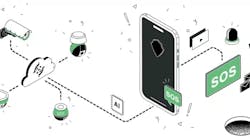With the rapidly changing landscape of security technology, it is often important to take a look at how your peers are seeing, dealing with and ultimately leveraging these evolutions. With that in mind, SD&I has brought together security systems integrators from diverse regions of the country to discuss emerging technologies and standards, and how these changes are impacting their customers, daily work and bottom lines.
Here’s what they had to say:
The Panel:
- Tom Hagen is President and CEO of Pro-Tec Design of Minneapolis, Minn.
- Henry Hoyne is VP of Professional Services at Northland Control Systems, Fremont, Calif.
- Bill Lawrence is Security Division Manager for CM3 Building Solutions Inc., Fort Washington, Pa.
- John Nemerofsky is President and CEO of Xentry Systems Integration of Columbus, Ohio.
- Ron Poulin is President and owner of Daytona Broadband LLC of South Daytona, Fla.
- Rob Simopoulos is President of Advance Technology of Scarborough, Maine.
What emerging technologies have you deployed recently and what problem did it solve for your customer?
Lawrence: Two things that come to mind are 4k cameras and IP cameras with analytics. The 4k cameras were used to view large areas such as school playgrounds and parking lots in great detail with a single camera deployment. These cameras have outstanding image quality and the ability to digitally zoom deeply into the recorded video. The cameras with analytics were used to watch an impound lot. The client wanted fence perimeter protection but also had active train tracks within a few feet of the lot. The camera analytics allowed us to remove the costly fence perimeter system and provide accurate perimeter protection along with HD video in a single system deployment.
Simopoulos: Our healthcare customers are seeing tremendous benefits in the Wi-Fi-based RTLS solution that we are installing. The single platform software allows us to tag infants with Wi-Fi-based tags that prevent elopement from protected areas. Since the system runs on the hospital Wi-Fi infrastructure, it provides campus-wide, real-time location coverage when the infant leaves the protected area. In addition to protecting infants, tags can be deployed to locate and manage assets (wheelchairs, pumps, beds), provide real-time temperature and humidity levels, and provide the security department staff duress options.
Poulin: IP recording devices with built-in PoE ports have been very popular. It creates a much cleaner installation with fewer devices and points of failure. Decreased installation time also reduces cost to the customer.
Nemerofsky: One of our hospital customers approached us about access control for surgical suites. The solution had to be accurate and fast. We chose iris recognition technology as it met those requirements, was simple to install, the registration process took only a minute or two per clinician and had the added benefit of being hands-free. The customer has been very satisfied.
Hoyne: We have deployed data aggregator platforms such as IDVS. Rather than having feeds such as NC4, weather, social media, etc. from multiple sources and applications, a single software and interface is all that’s needed. IDVS collects this data and displays it in a single graphical interface that is easy to digest. It also allows us to make correlation rules with those disparate feeds.
Hagen: IP video is no longer an emerging technology but we see applications emerging in new areas such as process control, traffic control, event management, etc. IP video has expanded beyond security-related applications to become a utility within corporate and government organizations serving many other business application requirements.
What are the most interesting or important video surveillance-related technologies and/or advancements that are affecting your business and how?
Poulin: For existing analog system upgrades, TV-HDI DVRs have become extremely popular. Customers can now upgrade to 1080p full HD video without having to re-cable the property. It overcomes most objections when selling upgrades. The low cost of the devices along with no need for cable replacement make upgrades a very affordable option with the introduction of this technology. In some cases, TV-HDI technology is used in new installations.
Hoyne: There is a big shift in thinking that there is no longer a need to have localized storage and that the cloud storages is the answer to everything. While there are applications that would dictate its deployment vs. traditional on-premise hardware, it is important to discuss the pros and cons with the client and for them to understand the pricing model before they make a final decision.
Nemerofsky: Hybrid video recorders capable of accommodating both analog and IP cameras are making it easier for us to migrate our customers from analog to IP-based camera systems. Few organizations can afford to entirely scrap major investments in analog legacy cameras. By adding IP cameras as analog units fail, we help our customers make the switch in a way that remains sensitive to their budgets.
Simopoulos: We see an increase in customers implementing ALPR solutions at their facilities. The benefits of being able to take license plate information and convert it to usable data has countless applications. As an example, we recently we deployed a solution at a weigh scale that reduced our customer’s manual work tremendously. When trucks arrived on the scale, the license plate data from the ALPR system was automatically compared to a database of vehicles with active permits. Once the automated license plate to permit comparison was complete, the system provided visual indication to the operator as to whether the truck could proceed through or if they needed to come in to the building to receive a permit.
Lawrence: The two major factors affecting our business are video analytics and the falling costs of megapixel cameras. Both have advantages, but the decline in pricing is also a concern since it will lead to reduced profit margins and substandard installations. Analytics allow us to make our system more effective while delivering a pro-active solution to our client. Any equipment that helps the client focus on potential events is worth the additional cost.
How have technology standardization efforts (ONVIF, PSIA, SIA, etc) impacted you?
Simopoulos: It is wonderful to see each of these groups continue to develop standardization in the industry. In the end, we are at the mercy of the manufacturers to work together and implement them. As an example, we were excited to learn about (SIA’s) OSDP and felt that it could add tremendous value to our customers if we began using it rather than Wiegand. The security features in comparison to Wiegand along with the ability to monitor device status was very attractive. After much research, we realized that not many of our current manufacturers had developed their panels to incorporate the ability to provide OSDP. This left us in a position to decide whether or not we wanted to change our company installation standards to include OSDP with the manufacturers that did support it and not on the ones that didn’t. More recently though, it seems that we are seeing OSDP gain momentum and many of these manufacturers now do have a planned date of release and we are excited to see that.
Hoyne: I have mixed feelings about these standardization efforts. While I am a big believer in standards, and it was an honorable attempt to unify devices/sources from various manufacturers, in the end it created substantial headaches. ONVIF, for example, was meant to create interoperability between any camera and any VMS manufacturer. The problem is that it diluted the offerings of the cameras. Rather than write true drivers for these cameras that would exploit their features, ONVIF was used — and, in most instances, only brought in video with limited flexibility. This was most evident with manufacturers that produced both the VMS and their own cameras. There wasn’t much of an incentive, for obvious reasons, to give a competitor in the camera space the same competitive edge.
Nemerofsky: The technology standardization efforts affect us — and the entire industry — by providing more reliability when specifying and installing products from different manufactures. This a good thing that allows us to choose products based on function, features and price without being limited to a single provider. We benefit and so do our end-users.
Lawrence: We primarily get involved with ONVIF and frankly it has been more of a letdown then a bonus. We seem to find shortcomings in the camera programming — primarily in regards to motion recording. At this time, I still avoid products that are not fully tested between the VMS and the camera.
Hagen: Much noise, but little direct impact so far.
How has wireless technology influenced your business and/or bottom line?
Lawrence: Wireless deployments have been extremely effective for us. They have allowed us to install HD cameras in locations that in the past would have been price-prohibitive in regards to site development. We find the technology to be solid in function.
Hoyne: Wireless technology has come a long way and is maturing as technology and innovation progresses. As far as wireless reader/lock technology, there has been an increasing need to simplify deployment and reduce costs wherever possible. Traditional installations require pulling cables from A to B, coring doors, fishing wires and a handful of devices per portal. With wireless readers/locks, it can reside on an existing (or private) network and requires minimal modifications to the door handle. Most units have the reader, door contact, REX and lock in a single chassis. This is especially useful in deployments such as dorms or residential units where structural obstacles prohibit typical installs.
What technologies/advancements are making it easier and more efficient for your service technicians?
Lawrence: The number-one advancement for field techs is auto focus. This saves us extreme amounts of labor in both the initial installation and the maintenance of the camera.
Hoyne: We are now using a video-based platform where the smartphone (or any smart device) can transmit audio/video back to a cloud-based head-end. This transmission allows for one-to-many or many-to-many —allowing our engineers or project managers to see what’s taking place in real-time to help triage a situation effectively and efficiently.
Hagen: We have implemented an ERP System that has enabled us to solidify our process control and measure its effectiveness. Establishing consistent and effective best practices puts each member of our team in position to deliver a high level of professional service to our clients.
Simopoulos: Our goal is to know that our customers are having a problem with their system before they do. We are beginning to see the security manufacturers embracing remote support and health monitoring technologies. Some are building their own health monitoring tools into their software, and some are even cloud-based solutions. Others are using standard IT-based protocols that allow traditional IT software tools to detect device failures or servers that are beginning to fail. These advancements are allowing our managed service engineers to detect and often repair our customers systems remotely without the need to deploy service technicians on site. This remote support and management is providing our customers a high level of customer service at a reduced cost.
What particular technologies or enhancements are creating new RMR opportunities for you?
Hoyne: Many companies do not have the resources to properly staff and support their own security operations; however, they still need fully integrated, standardized, and scalable physical security systems and operations. As a result, we have built our own Managed Services Global Security Operations Center (GSOC) that delivers comprehensive, high-end security services. From policies and procedures, alarm management, video verification, guard dispatch, employee 411, device audits and user management, the GSOC provides full-service, scalable security operations to companies with facilities anywhere in the world.
Simopoulos: Our unique White Glove Service program provides our customers with help desk services, proactive system health checks, system administration and managed services, along with a number of other unique offerings. This solution is providing us with significant amount of growth in contracted RMR along with providing a high level of customer service that our customers deserve.
Hagen: We consider recurring revenue differently than many others. We keep track of the number of accounts who provide us with six figure revenue year after year and work to increase the number of those accounts. The revenue may come from system expansions, various forms of service agreements, partner plans, etc.
Lawrence: Auto focus has greatly impacted the profitability of our PM programs. This function allows us to easily keep up the initial image quality of the cameras without removing the lens cover. Another major advancement is the ability to manage and upgrade multiple servers remotely or from a single location. This saves a tremendous amount of labor and helps ensure all servers are current at all times. Last would be remote monitoring of camera systems. This is a growing opportunity and certainly will become more mainstream in the near future.
Paul Rothman is Editor-in-Chief of Security Dealer & Integrator (SD&I) magazine (www.secdealer.com).


